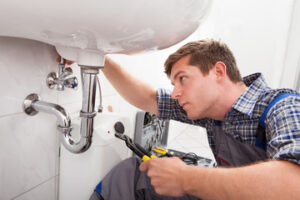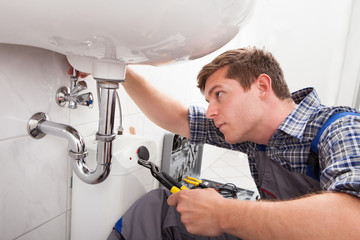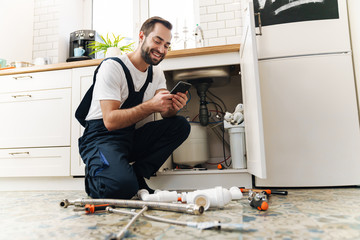Plumbing is a highly specialized career that requires extensive training and experience. It’s a trade that provides a good living and offers the opportunity to make a difference in people’s lives.
Most homes get their water from a main pipe that runs parallel to the street. From there, water flows under high pressure to various parts of the house. Visit https://www.plumbing-express.com/ to learn more.
When you flush a toilet, drain a sink or turn on a faucet, a complex system of pipes works to carry water and waste away from the fixture. This drainage and supply piping is a vital part of your plumbing, but it does not function alone. It needs the movement of air provided by a ventilation system to transport wastewater and remove odiferous sewer gases.
A drain-waste-vent (DWV) system connects all fixtures within a building to both the sewage line and the vent pipe. The system combines the drain and vent functions to provide continuous, unimpeded movement of water and waste. Without a properly functioning vent system, your home or commercial structure could experience costly drain blockages and dangerous gas buildups.
Vents regulate atmospheric pressure in your pipes to balance the forces of gravity and air pressure. This prevents negative pressure conditions that can slow down and clog drain lines, as well as vacuum conditions that can force waste into the building and cause odor problems.
Plumbing vents also allow air to enter the drainage system to fill the vacuum created when water and waste move down a pipe. This prevents the formation of pressure differences that can interfere with drain flow and promotes odor control by keeping harmful sewer gasses from seeping back into living spaces.
Another critical function of plumbing vents is to maintain the water seal in P-traps, which blocks the entrance of waste and sewer gases into your home. Without a properly functioning plumbing vent, pressure fluctuations can siphon water out of the P-trap, causing the crucial water seal to break and allowing unwanted sewer gases into your home. Vents introduce air into the drainage system at high points to maintain proper atmospheric pressure and keep your trap seals intact.
Plumbing vents also help prevent harmful sewer gasses from entering your living space by allowing them to escape into the atmosphere through the roof. Sewer gases contain potentially hazardous substances like methane and hydrogen sulfide, which can be deadly if inhaled. Vents allow these gases to exit through the roof, preventing them from building up inside your home and releasing obnoxious odors.
Fixtures
The fixtures of a plumbing system include sinks, toilets, faucets, showers, and bathtubs. They are the elements that homeowners interact with daily and can influence the aesthetic of each room. The selection of plumbing fixtures depends largely on personal preference and the overall design theme of the home. The available options range from sleek and contemporary to traditional and rustic, with each offering different benefits.
When selecting fixtures, homeowners should prioritize quality over style. High-quality fixtures are less prone to wear and tear, require less maintenance, and offer greater longevity. In addition, they are often more energy-efficient than older models, resulting in substantial financial savings over time.
Another important factor when choosing fixtures is their ability to withstand water pressure and temperature. The type of materials used in a fixture is vital, as different materials offer varying levels of durability and resistance to corrosion. For example, stainless steel and brass are durable options that can withstand high levels of heat and pressure.
In addition to their functionality, fixtures must be designed for ease of cleaning and maintenance. For example, the installation of a drip-free faucet can greatly reduce the risk of water spots and stains. Additionally, a low-flow toilet can save water and money by reducing the amount of water that is consumed during use.
Upgrading to water-efficient fixtures is a wise investment that offers many advantages for the homeowner and the environment. In addition to lowering water consumption, these fixtures can also help homeowners conserve energy by using less hot water for washing dishes, showering, and doing laundry. Furthermore, they can help improve a home’s resale value and marketability by making it more appealing to environmentally-conscious buyers.
Choosing the right plumbing fixtures can enhance the beauty and functionality of any space in your home. Whether you’re remodeling an existing bathroom or building your dream kitchen, the right fixtures can make all the difference. By prioritizing style and quality, you’ll be able to find the perfect fixtures for your home’s unique style. With so many options on the market, it’s essential to work with a professional team who can help you select the best fixtures for your home.
Force Mains
Sewer force mains are used in areas where gravity can’t transport wastewater from low-lying areas up to area treatment plants. These pressurized sewer pipes rely on mechanical pumps in a pump station to create the necessary pressure to transport wastewater uphill toward its destination. They are also used to overcome obstacles such as rivers and other bodies of water.
Force mains may be buried underground or located above ground. If buried, they are usually in trenches, although boreholes may be utilized in locations where excavation is impractical. If above ground, they are often on pylons or suspended from bridges. Sewer force mains are usually 8 inches in diameter or larger and are made of materials such as ductile iron pipe, polyvinyl chloride or high-density polyethylene (HDPE).
The lifespan of a sewer force main depends on the quality of material and site conditions. Corrosion is a major cause of failure for this type of pipeline, and can lead to breaks or leaks. The corrosive nature of sewage, soil chemistry and the water table can all play a role in corrosion. In addition, ground settling and external forces can impact the life expectancy of a force main.
To maximize the longevity of a sewer force main, it’s important to maintain an ongoing maintenance program. This should include regular cleaning and televising of the line as well as testing and inspection of the pump station. A routine maintenance program can help to prevent issues such as clogs, breaks and leaks, as well as corrosion and other damage.
If a sewer force main is connected to a house service line, it should have a corporation stop, a valve that enables the service line to be disconnected from the municipal supply without shutting off the water flow to the building. It should also have a waste valve, a valve that allows the water in the service line to be emptied out for repairs.
Depending on the site conditions, the sewer force mains may discharge to a sewage pump station wet well or a wastewater treatment plant. If a force main discharges to more than one of these components, they are usually connected in a manifold system. Each force main will have its own pump, which will either pump the wastewater to the next pipe in the manifold or to the wastewater treatment plant.
Tank
The tank of a plumbing system serves two important purposes: storing water for consumption, and flushing waste. It can be made of any of three main materials, including steel, polypropylene, or diaphragm. Each has its own advantages and disadvantages, so the type of tank used will depend on the specific project and budget. A professional plumber in Grand Prairie can recommend the best options for a given situation.
The most common tank is a stainless steel model with a top-mounted flush valve. The valve has a chain that lifts the flapper, allowing water to flow downward by gravity to cleanse the toilet bowl. The tank also has a fill valve and an overflow tube. The fill valve opens to refill the tank when the float drops, and it closes once the tank is full. The overflow tube safeguards against accidental tank overflow.
Another option for a plumbing tank is a plastic tank with a flange-mounted flush valve. This type of tank can be less expensive than a stainless steel tank, but it does not offer the same level of durability. It may also be prone to cracking or warping, making it more susceptible to rust and corrosion than other tanks.
A third option for a plumbing tank is a pressure-rated expansion tank. These tanks are filled with a hermetically sealed chamber of compressed air or nitrogen gas at higher pressures than non-pressurized tanks. This prevents thermal expansion and contraction from putting excessive pressure on the tank walls, and it allows the tank to provide more consistent water pressure throughout a home or business.
When installing a new flush valve, first remove the tank from the bowl and set it on a plastic drop cloth where you have room to work. Then, remove the tank-to-bowl gasket from the threaded flush valve tailpiece that extends from the bottom of the tank. Next, remove the retaining nut holding the valve in place and pull the valve out of the tank. Replace the tank-to-bowl gasket, then screw the new valve into place with a flanged washer and a neoprene nut. Tighten the nut by hand to make sure it is secure, but don’t over-tighten.


